Azeitão (São Lourenço e São Simão)
| Azeitão (São Lourenço e São Simão) | |
|---|---|
| Civil parish | |
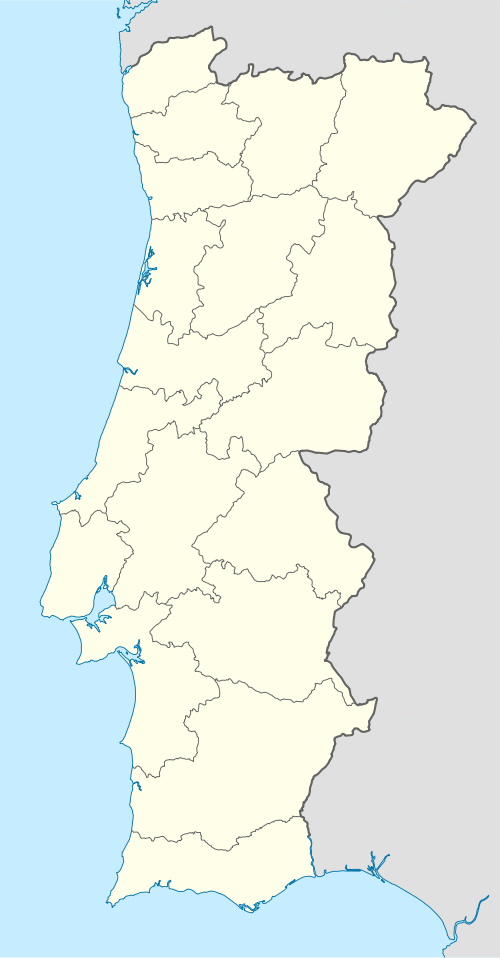 Azeitão (São Lourenço e São Simão) | |
| Coordinates: 38°31′08″N 9°00′58″W / 38.519°N 9.016°WCoordinates: 38°31′08″N 9°00′58″W / 38.519°N 9.016°W | |
| Country | Portugal |
| Region | Lisbon |
| Subregion | Península de Setúbal |
| Metropolitan area | Lisbon |
| District | Setúbal |
| Municipality | Setúbal |
| Area | |
| • Total | 69.32 km2 (26.76 sq mi) |
| Population (2011) | |
| • Total | 18,877 |
| • Density | 270/km2 (710/sq mi) |
Azeitão (São Lourenço e São Simão) is a civil parish in the municipality of Setúbal, Portugal. It was formed in 2013 by the merger of the former parishes São Lourenço and São Simão.[1] The population in 2011 was 18,877,[2] in an area of 69.32 km².[3] It is composed of a cluster of small "aldeias" or small villages, some of those are: Vila Fresca de Azeitão, Vila Nogueira de Azeitão, Brejos de Azeitão, Aldeia de Irmãos, Vendas de Azeitão. Two of the closest cities are Setúbal and Palmela.
Heritage
- Church of São Lourenço: From the primitive Gothic temple nothing remains as proof, and what we see today is a church with 18th century tiles, carving and some paintings.[4]
- Fountain of the Stunned: It gained its name due to the admiration that its contemplation caused. It is said that whoever drinks from these waters is permanently attached to the locality.[4]
- José Maria da Fonseca Cellars and its Wine Museum: Housed in a 19th-century building, they showcase the old machinery to demonstrate how things evolved over a period of 150 years.[4]
- Azeitão Tile Factory: It maintains the tradition of producing completely manual tiles, using the stoneware technique.[5]
- Palace of the Dukes of Aveiro: Built in the 17th century, it is a symbol of the aristocratic past of the land. However, it is not visible. In front of it stands the pillory.[4]
- Quinta das Torres: Sixteenth-century noble house that is now an inn with restaurant and tea house. It has a lake and a small fresh house in the center.[6]
- Quinta da Bacalhoa: Famous not only for its wine, but also for hosting an important tile heritage of the 15th and 16th centuries.[6]
In Azeitão there are several farms, some of them dedicated to wine production, cheese, and the famous Azeitão pies. Others are owned by famous people, such as Herman José, Manuel Vilarinho, or the former president of Sporting Clube de Portugal, Filipe Soares Franco.
Azeitão is the birthplace of the poet and pedagogue Sebastião da Gama, known for his poems about the Nature Park of Arrábida, who died prematurely at age 27, victim of tuberculosis.[7] The parish pays several respects to the poet, especially in the house where he was born and in the Museum-Library Sebastião da Gama.[8]
In 2014, Azeitão cheese was considered one of the 50 best gastronomic products in the world, distinguished by the Great Taste Awards, organized by the Guild of Fine Food (Ireland), known as the Oscars of Gastronomy.[9]
In June 2015, it was announced the creation of a museum that pays homage to Azeitão shepherds and cheese. It is called Ovelheiro Museum and is located in Palmela.[10]
.jpg)
 Vila Nogueira (Dukes of Aveiro palace)
Vila Nogueira (Dukes of Aveiro palace) Marketplace
Marketplace Fountain
Fountain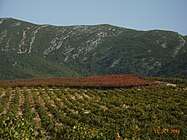 Vineyards around
Vineyards around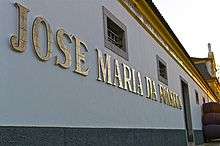 José Maria da Fonseca wine cellars
José Maria da Fonseca wine cellars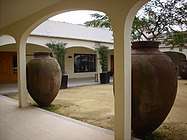 Quinta de Catralvos wine cellars
Quinta de Catralvos wine cellars.jpg) Tortas cake
Tortas cake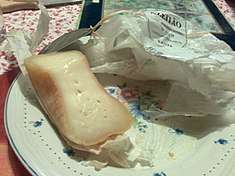 Queijo cheese
Queijo cheese- JP Azeitão Branco white wine
| Wikimedia Commons has media related to Azeitão (Setúbal). |
References
- ↑ Diário da República. "Law nr. 11-A/2013, page 552 114" (pdf) (in Portuguese). Retrieved 31 July 2014.
- ↑ Instituto Nacional de Estatística (INE), Census 2011 results according to the 2013 administrative division of Portugal
- ↑ Direção-Geral do Território
- 1 2 3 4 Paula Oliveira Silva (5 October 2004). "Nobility and wines in Azeitão". Lifecooler. Retrieved 20 June 2016.
- ↑ "Azeitão Tile Factory - Setúbal makes tiles for Church in Gabon". Rostos.pt. 23 August 2014. Retrieved 20 June 2016.
- 1 2 Paula Oliveira Silva (5 October 2004). "Nobility and wines in Azeitão". Azeitão.net. Retrieved 20 June 2016.
- ↑ "Azeitão: Sebastião da Gama was honored today in his homeland". Zoom. 10 April 2014.
- ↑ "Setúbal remembers the poet of Arrábida - Sebastião da Gama's 90th Birthday". Rostos.pt. 10 April 2014. Retrieved 27 July 2016.
- ↑ "Azeitão cheese among the best products in the world". Boas Notícias. 10 November 2014. Retrieved 27 July 2016.
- ↑ "Palmela already has an Ovelheiro Museum". SIC Notícias. 4 June 2015. Retrieved 27 July 2016.
External links